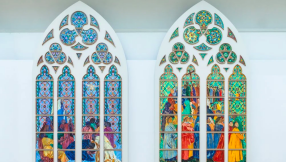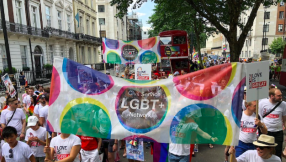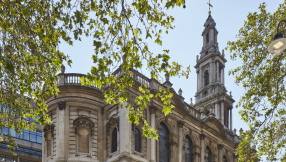
In the UK church bells which had remained silent during the war, rang again on VE Day in 1945. This is the story …
Bells in the Bible
The idea of church bells come from the instructions for worship given to Moses and Aaron in Exodus 28:31-35. The book of Exodus records instructions that the High Priest’s robe should include golden bells on its hem the “sound shall be heard when he goeth in unto the holy place before the LORD”. The bells rang to signify that the priest was going into the holy place of worship.
History of church bells
Church bells began to be used in Christian churches in the fifth century AD, and widely from the seventh century. Over time, they developed into a powerful symbol of time and worship. For many centuries in Europe, in days before people had clocks or watches, the ringing of a church bell signified that a service was about to start. In villages someone in the tower might see the priest arriving from the local town, coming in the distance on horseback, and someone would ring the bell to gather the congregation before he arrived. Historically church bells have been used as a call to worship, and to announce momentous events such as funerals, weddings, but also emergencies and victories.
First World War
Church bells were silenced during the First World War. In 1914, the British Defence of the Realm Act had limited bell ringing. When church bells rang on Armistice Day, 11 November 1918, this announced the end of the war.
Silencing the bells
During the war in Germany, church bells were confiscated by the Nazis. They were seen as a valuable metal resource for the war effort. In the UK, despite metal being collected from other places to plug severe material shortages, British church bells were not requisitioned because the government recognised their spiritual and cultural significance.After the evacuation from Dunkirk in June 1940, the apparent threat of German invasion led the British government to order that church bells across the land be silenced.
The order was made on 13 June 1940 by the British Ministry of Home Security, which banned church bell ringing. Bells could not be rung as a call to worship and nor could they be used for weddings nor funerals. Instead, their role was restricted as a potential signal of invasion by the enemy. If German troops were to invade, the ringing of church bells would effectively be an alarm call to rally the Home Guard forces and warn civilians of invasion. The move to ban church bells also avoided confusion during air raids.
Exceptions
An exception to the ban was made in 1942, when Winston Churchill ordered a temporary lifting of the ban to allow church bells to ring to mark the Allied victory at El Alamein, on 15 November 1942. Technically the ban on church bells was officially partly lifted in 1943, for Christmas Day and special occasions. However, in many places there was a lack of bell ringers, and there was no longer a functioning bell ringing group. In any case there was often uncertainty about what classed as a special occasion. This meant that effectively in many towns and villages, church bells had simply not been rung at all since 1940.
VE Day 1945
A mark of VE Day in 1945, was that churches could ring bells again. The sound of church bells rang across the country, not to mark invasion, but the end of the war in Europe. A spontaneous joy, sense of relief and communal spirit erupted across the land as people heard church bells ringing out.
For many people, the sound of the bells, which had been silent for five years, was an emotional and profound symbol of the return of normal life. Instead of the wartime sound of air raid sirens and aircraft overhead, church bells were a welcome sound of freedom and God’s mercy, that people had waited years to hear them again. For many, it was a deeply emotional moment, because church bells were a sound associated with weddings, worship, and community, which were now restored. Church bells have long been a traditional and welcome call to prayer and thanksgiving for Christians. On VE Day 1945, they summoned people to churches for special services of thanksgiving to mark the end of war.













